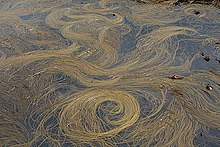Belt tang
| Belt tang | ||||||||||||
|---|---|---|---|---|---|---|---|---|---|---|---|---|

Belt Tang ( Himanthalia elongata ) |
||||||||||||
| Systematics | ||||||||||||
|
||||||||||||
| Scientific name | ||||||||||||
| Himanthalia elongata | ||||||||||||
| ( L. ) SFGray |
The belt tang ( Himanthalia elongata ) is a brown algae from the order of the Fucales . Native to the Northeast Atlantic, it is also found in the North Sea and the Baltic Sea. In some countries it is consumed as "sea spaghetti".
description
The belt tang is anchored to the ground by an adhesive disk. The olive-brown thallus is divided into two parts: at the base there is a stalked, button- to cup-shaped vegetative structure about 2 to 5 cm in height and diameter. From the middle rise up to four very long, narrow, belt-shaped bands that branch out in multiple bifurcations. They reach a length of 1 to 2 (rarely up to 3) m and a width of 5 to 10 mm.
Often you only find the torn ribbons tangled up on the beach, which probably led to the English name Sea-Spaghetti (= sea spaghetti).
development
The belt tang is a diplont without a generation change. On the surface of the thallus ligaments, the reproductive organs, point-like conceptacles , are irregularly distributed. Antheridia and oogonia arise on separate specimens. The antheridia release motile spermatozoids. Each oogonium only forms one egg cell.
After fertilization, the zygote grows into a "bowl" in late summer. In the winter, usually in January and February, starting from the fertile Thallusbänder ( seminal receptacles ) to grow out and bifurcate four to six times. Later, they just lengthen and thicken without forking again. They reach reproductive maturity in July to September.
Occurrence
The belt tang is common in the Northeast Atlantic from Scandinavia ( Faroe Islands ) to Portugal and Spain . It is also found in the North Sea and the Baltic Sea . It is only temporarily at home near Heligoland , but it can regularly be found there washed up on the beach after storms in late summer.
The belt tang colonizes gently sloping rocks in the lower tidal zone . It can occur in clear belts on the lower low water line, especially in places protected from surf.
Systematics
The first description of the belt gang was in 1753 by Carl von Linné under the name Fucus elongatus (In: Species Plantarum , Volume 2, p. 1159). Samuel Frederick Gray placed the species in the genus Himanthalia Lyngbye in 1821 (In: A natural arrangement of British plants , Volume 1, p. 389). The belt tang is the only species of this genus that was established by Hans Christian Lyngbye in 1819.
Synonyms for Himanthalia elongata (L.) SFGray are Fucus elongatus L., Fucus loreus L., Fucus pruniformis Gunnerus, Fucus tomentosus Hudson, Funicularius tuberculatus Roussel, Himanthalia lorea (Linnaeus) Lyngbye, Spongia dichotoma Hudson and Ulva tomentosa ( Hudsonva tomentosa ) .
Himanthalia elongata is the only member of the Himanthaliaceae (Kjellman) De Toni family within the order of the Fucales .
use
In France and Ireland, the belt tang is traded as a food under the name "sea spaghetti" or "sea beans". For this purpose, the thallus bands are dried, cut to finger size and packed. After soaking in water, they are used in salads. The taste is described as mild.
swell
- Wolfram Braune: marine algae. A color guide to the common benthic green, brown and red algae of the world's oceans . Ruggell: Gantner, 2008, ISBN 978-3-906166-69-8 , pp. 242-243. (Sections Description, Occurrence, Use)
Individual evidence
- ↑ a b P. Kornmann, PH Sahling: Sea algae from Helgoland - Benthic green, brown and red algae. Biological Institute Helgoland, Hamburg 1983, ISSN 0017-9957 , pp. 170-172.
- ↑ a b c Michael Guiry: The Seaweed Site: information on marine algae: Himanthalia elongata , accessed February 11, 2013.
- ^ A b Michael D. Guiry, GM Guiry: Himanthalia elongata - In: Algaebase - World-wide electronic publication, National University of Ireland, Galway , accessed on April 12, 2012.

